Should you lease or buy an electric car? Top 9 considerations

The Bankrate promise
At Bankrate we strive to help you make smarter financial decisions. While we adhere to strict , this post may contain references to products from our partners. Here's an explanation for .
Key takeaways
- Leasing an electric vehicle (EV) can be a good first step in transitioning to an EV, as it allows you to test out the driving experience without committing to full ownership.
- Leasing an EV typically results in a lower monthly payment compared to buying, but you won't build equity in the vehicle or have the ability to customize it.
- Buying an electric car can be a better option for drivers who want full ownership and the ability to modify their vehicle, but it may come with a higher upfront cost and potentially steep depreciation.
- The choice between leasing and buying an EV ultimately depends on personal preferences and financial considerations.
The amount of choices for those considering getting behind the wheel of an electric vehicle has dramatically grown over the years as options have expanded. A recent study from GBK Collective found that 50 percent of U.S. households are considering an EV, plug-in hybrid or hybrid for their next vehicle.
But even as available electric vehicle models multiply, choosing and shopping for your first EV can be daunting. If you fall into this camp but are not ready to dive in head-first, leasing an EV can be the right first step. Buying, on the other hand, is best suited for drivers who are ready to commit.
Leasing an electric car
The process of leasing a vehicle allows you to have a vehicle for a set number of miles and months. Leases tend to cost less than purchasing a vehicle through an auto loan — an average of $132 less on top models, according to recent Experian data. You can use a lease calculator to determine how much it will cost in total to lease the model you’re considering.
Benefits of leasing an electric car
Leasing an electric car can allow you to test out the driving experience to decide if it fits into your lifestyle.
- Vehicle warranty: While leasing, your vehicle will still be covered by its manufacturer warranty. This could help you save thousands of dollars on expensive repairs, like replacing the battery.
- Lower monthly payment: Leasing often results in a lower monthly payment. This is because your payments are only based on the duration of the lease and the expected sale price when the lease period is up. In addition, you could avoid a large down payment — although this could mean a higher monthly payment.
- Newest tech features: While model changes year over year for conventional vehicles are not dramatic, the EV field is advancing much faster. Leasing allows you to be on the cutting edge of available technology rather than being stuck with last year’s add-ons.
Drawbacks of leasing an electric car
EV or otherwise, leasing of any kind comes with some notable downsides that you should consider.
- No equity: Just like with any other lease, leasing an EV leaves you without equity when the lease ends. Since you have to give back your vehicle, everything you paid up to that point can’t be recouped. You won’t be able to use the vehicle as a trade-in, and you cannot get back the money you put down.
- Difficult to end early: Leaving a car lease is not easy or inexpensive. If you do not like the vehicle you lease, you will likely be expected to pay hefty fines to exit the lease agreement. Depending on your lessor, you may be expected to pay out the residual value in addition to remaining lease payments and fees.
- Vehicle restrictions: When signing off on an auto lease, there are a few main aspects to look out for: mileage, maintenance and vehicle modification. If you lease your EV, you will likely be limited to driving anywhere from 12,000 to 15,000 miles a year. You will also have to foot the bill for vehicle maintenance and cannot customize the vehicle.
When does buying an electric car make sense?
Most importantly, buying an EV makes sense if you can afford it. These vehicles tend to cost more than their gas-powered counterparts. And while the lifetime cost can lower, the immediate monthly and ongoing costs should be your first consideration. EV ownership is also fitting for drivers who have done their research and understand how vehicle range fits into their driving habits.
Benefits of buying an electric car
Having full ownership of your vehicle will ensure you aren’t checking the odometer every time you push start, but there are other benefits to consider as well.
- Full ownership: Depending on where you stand financially, buying an EV can allow you to pay off your loan at your own speed and place you in total control of your vehicle. You will have a firm grasp on your total cost upfront instead of worrying about potential wear-and-tear or mileage overage charges that can add up at the end of a lease.
- No vehicle restrictions: If you feel that the freedom of the open road should not be restricted, then buying an EV might be a better option for you. This way, you will not be held captive by the vehicle’s odometer and can enjoy driving and modifying your car as much as you want.
- Tax incentives and credits: When purchasing an EV, you can benefit from a multitude of financial incentives. The federal EV tax credit, for example, can be worth up to $7,500 dollars. Many states also offer rebates to lower the cost of purchasing a climate-conscious vehicle. You may still be able to take advantage of the federal tax credit when you lease a vehicle, but the road to savings isn’t as straightforward.
Drawbacks of buying an electric car
Buying an EV can cost you more upfront, and with rapid tech changes, ownership carries some clear downsides.
- Expensive upfront cost: Electric vehicles tend to be more expensive than conventional vehicles. A new EV averages $52,314, according to Cox Automotive. EV drivers also tend to carry almost identical credit profiles to those financing luxury cars and pay large down payments, according to a TransUnion report. This can make getting approved for a loan more of a challenge for borrowers with less-than-perfect credit scores.
- Rapidly changing tech: Innovation in the electric car field is rapid, and that growth is the downside to buying. You won’t be able to take advantage of upgrades unless you sell your car and buy a new one — which can be an expensive route. Advancements in battery life and changing charger standards may make leasing a better option.
- Potentially steep depreciation: That same changing tech could also lead to steep depreciation. If the car you buy now is no longer being produced in a few years, it could lose much of its value. In addition, companies, like Tesla, slashing prices on their models means that you could pay tens of thousands of dollars more for a car than it will be worth in just a few months.
Is it better to lease or buy an electric car?
Determining if leasing or buying an EV is right for you requires the same forethought as when determining a route for any type of vehicle. Leasing is best for those who want to test out a vehicle and secure a lower monthly payment, while buying is better for a driver who wants full control of the car. However, when it comes to driving electric, leasing can be a good first step so you can determine if you enjoy the experience.
As EV options have expanded, more drivers have decided to lease — just over 30 percent in the fourth quarter of 2023, according to Experian. However, 48.8 percent chose to finance with an auto loan instead of leasing. Either route you take, EVs may offer a positive driving experience for you and the planet and are a strong consideration for your next car.
The bottom line
For some, the benefits of the newest available tech may outweigh the lack of full ownership — while, for others, getting behind the wheel of a vehicle with confidence and incentives makes more sense.
If you decide to buy an EV, do your research to understand the additional costs associated with ownership and take advantage of green auto loans. On the other hand, leasing an EV requires the same attention as leasing a gas vehicle. Review a few offers and understand the contract before committing to a lease.
Related Articles



